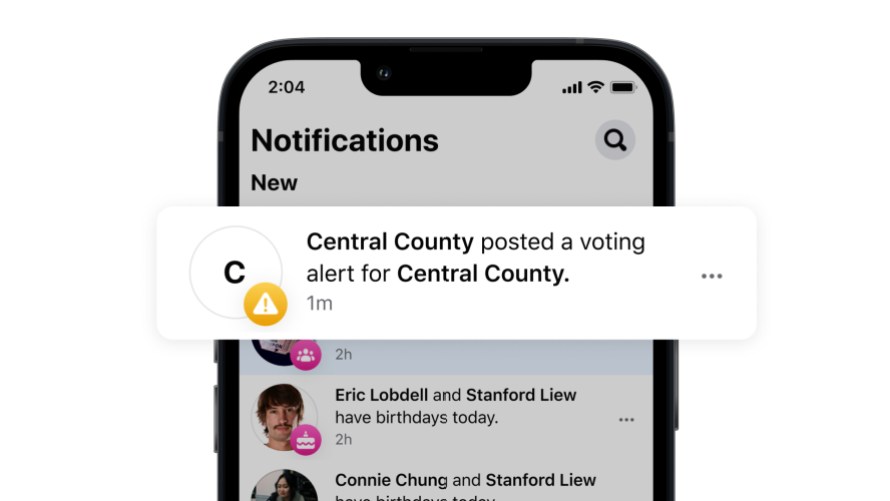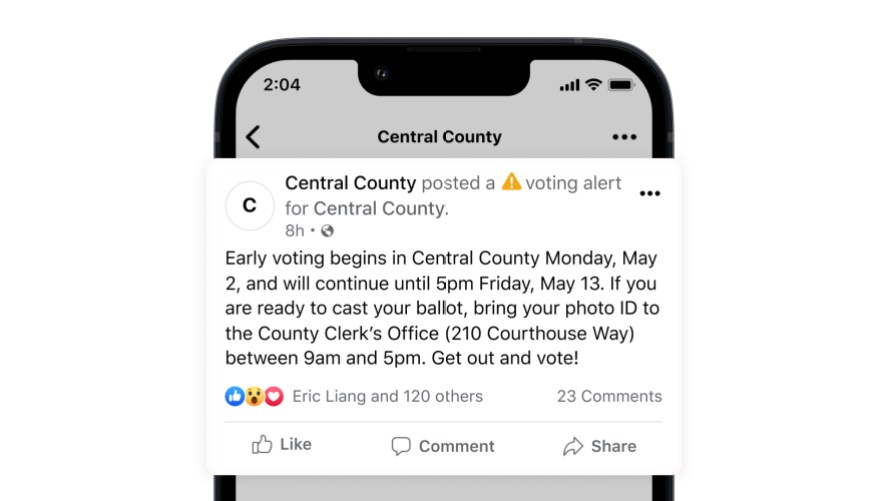
In recent years, Meta has developed a comprehensive approach to how elections play out on our platforms. With the 2022 US midterms on the horizon, we are setting out how our approach applies in this election cycle, which is largely consistent with the policies and safeguards we had in place during the 2020 US Presidential election.
Meta invests a huge amount to protect elections online — not just during election periods but at all times. We spent approximately $5 billion on safety and security last year alone, and have hundreds of people dedicated to this work permanently embedded across more than 40 teams. With each major election around the world — including national elections this year in France and the Philippines — we incorporate the lessons we learn to help stay ahead of emerging threats.
Our approach to the 2022 US midterms applies learnings from the 2020 election cycle and exceeds the measures we implemented during the last midterm election in 2018. This includes advanced security operations to fight foreign interference and domestic influence campaigns, our network of independent fact-checking partners, our industry-leading transparency measures around political advertising and pages, as well as new measures to help keep poll workers safe. As we did in 2020, we have a dedicated team in place to combat election and voter interference while also helping people get reliable information about when and how to vote.
Preventing Election and Voter Interference
We continually review content to determine if it violates our Community Standards, including our policies on election and voter interference, hate speech, coordinating harm and publicizing crime, and bullying and harassment.
Our teams fight both foreign interference and domestic influence operations, and have exposed and disrupted dozens of networks that have attempted to interfere with US elections. We’ve banned more than 270 white supremacist organizations, and removed 2.5 million pieces of content tied to organized hate globally in the first quarter of 2022. Of the content we removed, nearly 97% of it was found by our systems before someone reported it. We’re also investing in proactive threat detection and expanding our policies to help address coordinated harassment and threats of violence against election officials and poll workers.
We work with a range of partners to ensure we’re as prepared as possible, including state and local election officials, the federal Cybersecurity and Infrastructure Security Agency, and industry peers. This includes meeting regularly with the National Association of Secretaries of State and the National Association of State Elections Directors.
As was the case in the US in 2020, election-related content we will remove includes misinformation about the dates, locations, times, and methods of voting; misinformation about who can vote, whether a vote will be counted, and qualifications for voting; and calls for violence related to voting, voter registration, or the administration or outcome of an election. We will reject ads encouraging people not to vote or calling into question the legitimacy of the upcoming election.
We will also prohibit new political, electoral and social issue ads during the final week of the election campaign, as we did in 2020. Ads that have previously run before this restriction period will be allowed to run during this time. To simplify the process from the last cycle, any edits related to creative, placement, targeting and optimization won’t be permitted. Our rationale for this restriction period remains the same as 2020: in the final days of an election, we recognize there may not be enough time to contest new claims made in ads. This restriction period will lift the day after the election and we have no plans to extend it.
Connecting People With Reliable Information
We’re continuing to connect people with details about voter registration and the election from their state election officials through Feed notifications and our Voting Information Center. Throughout the primary elections, we’ve shown people reminders directing them to information on how to register and when and how to vote.
State and local election officials continue to use our Voting Alerts on Facebook to send the latest information about registering and voting to people in their communities, and there have been more than 80 million election-related notifications so far this year. We’re also elevating post Comments from local elections officials to ensure people have as much reliable information as possible about how, when and where to vote.
This year, we’re also showing election-related in-Feed notifications in a second language other than English if we think the second language may be better understood. For example, if a person has their language set to English but is interacting with a majority of content in Spanish, then we will show the voting notifications in both English and Spanish.
On Instagram, we launched our “I Voted” and “Register to Vote” stickers in the Stories tray during primary season, and will soon add more stickers for people to share their plans for how to vote.
While some of the challenges in 2020 were unique, we are once again prepared to respond to content discussing the integrity of the election by applying labels that connect people with reliable information. In the 2020 election cycle we received feedback from users that these labels were over-used, so in the event that we do need to deploy them this time round our intention is to do so in a targeted and strategic way.
We have 10 fact-checking partners in the US to address viral misinformation, including five who cover content in Spanish. We add warning labels to content they debunk so that people can decide for themselves what to read, trust and share. We’re also investing an additional $5 million in fact-checking and media literacy initiatives ahead of the midterms. This includes partnering with Univision and Telemundo to launch fact-checking services on WhatsApp; providing financial support to US fact-checking partners to help them increase their capacity during the elections; and supporting the development of English and Spanish language media literacy resources to teach people how to identify misinformation for themselves.
Transparency Around Elections and Advertising
Since 2018, we have provided industry-leading transparency for ads about social issues, elections or politics. Advertisers who run these ads are required to complete an authorization process and include a “paid for by” disclaimer. These ads are then stored in our publicly available Ad Library for seven years.
Our Custom Spend Tracker is available in the US as part of our Ad Library Report, which helps people understand how much specific advertisers, candidates and political parties are spending to reach voters. This spring, we announced that we are bringing even more transparency to social issues, electoral and political ads by providing information about advertiser targeting choices. Page-level targeting data is displayed in a new “Audience” tab in the Ad Library. And through Facebook Open Research and Transparency (FORT) we are now making detailed targeting information available for vetted academic researchers. This is an expansion of a pilot launched last year, with data now available for all social issues, electoral and political ads run globally since August 2020.
For more information about how Meta approaches elections, visit our Preparing for Elections page.
The post How Meta Is Planning for the 2022 US Midterms appeared first on Meta.

















 English (US) ·
English (US) ·